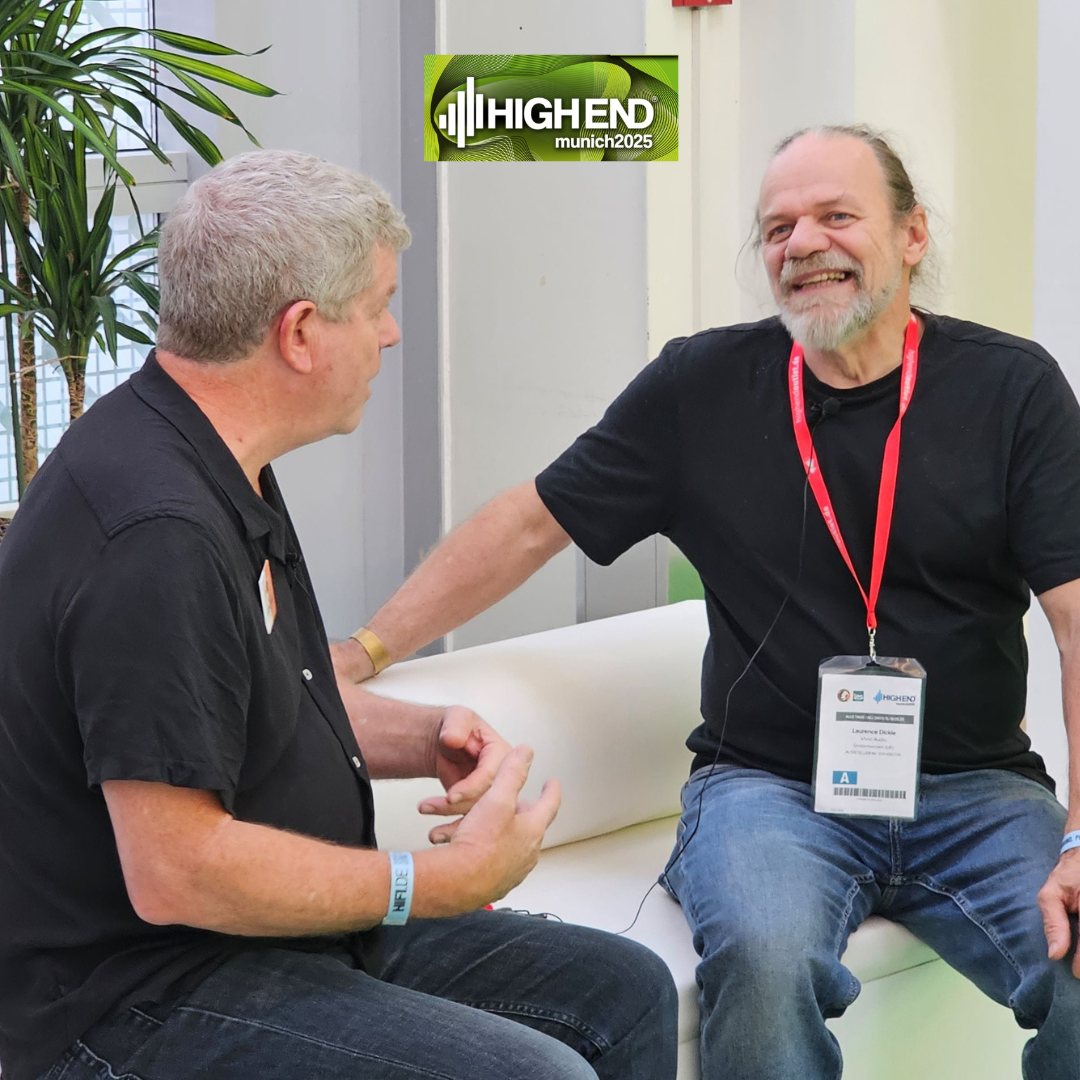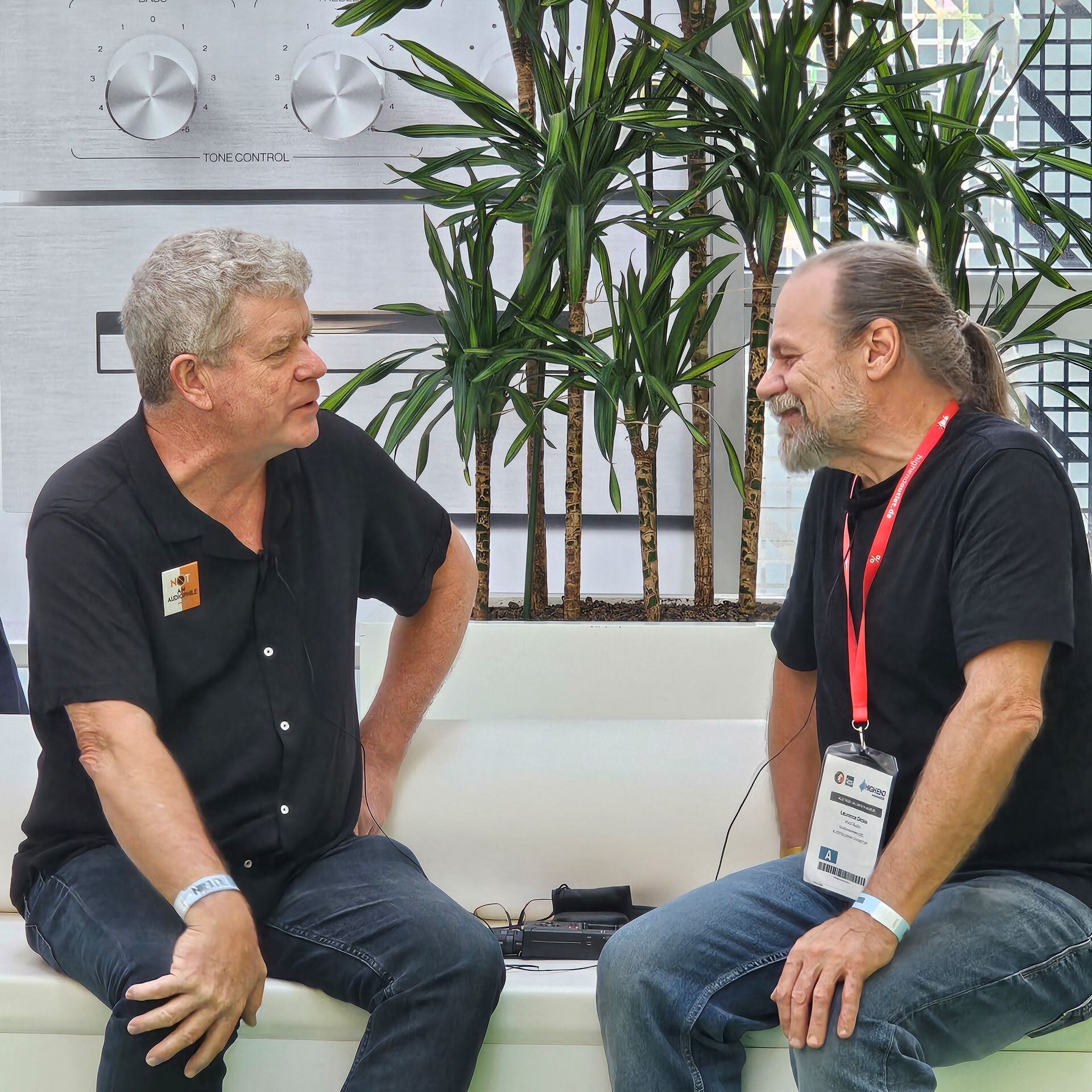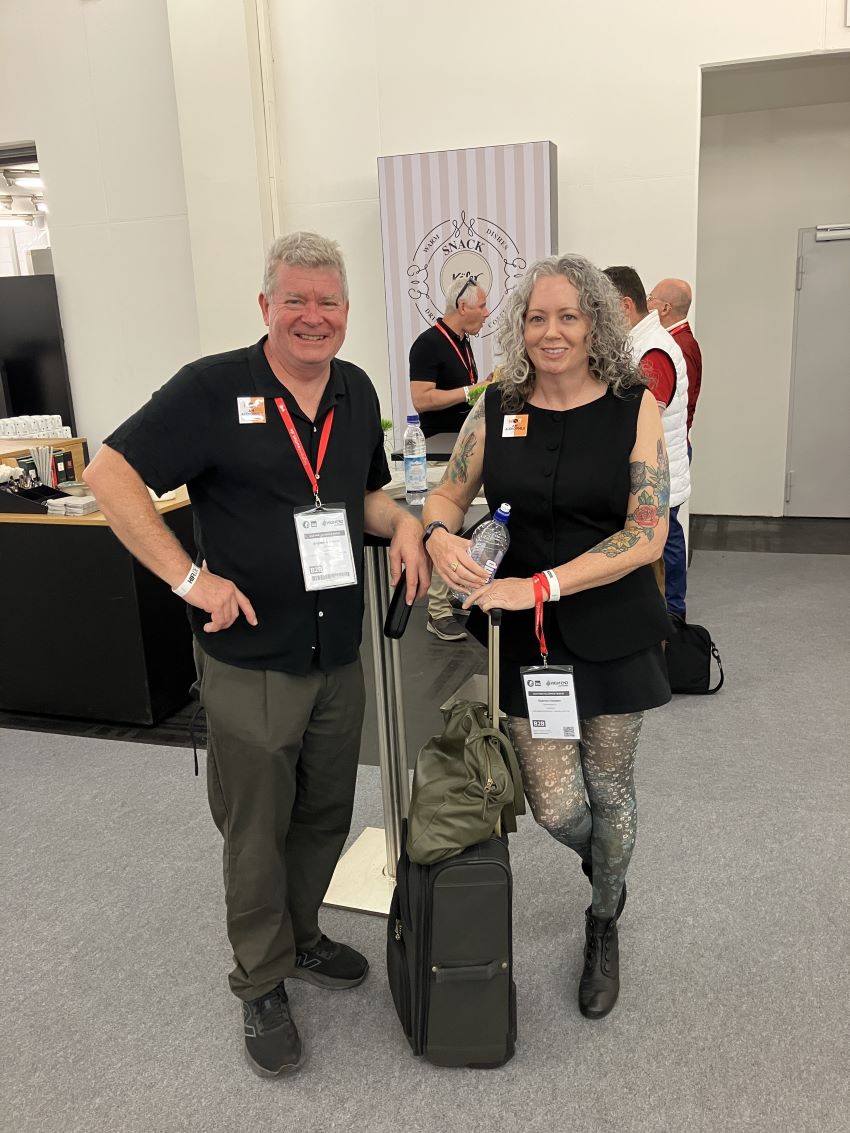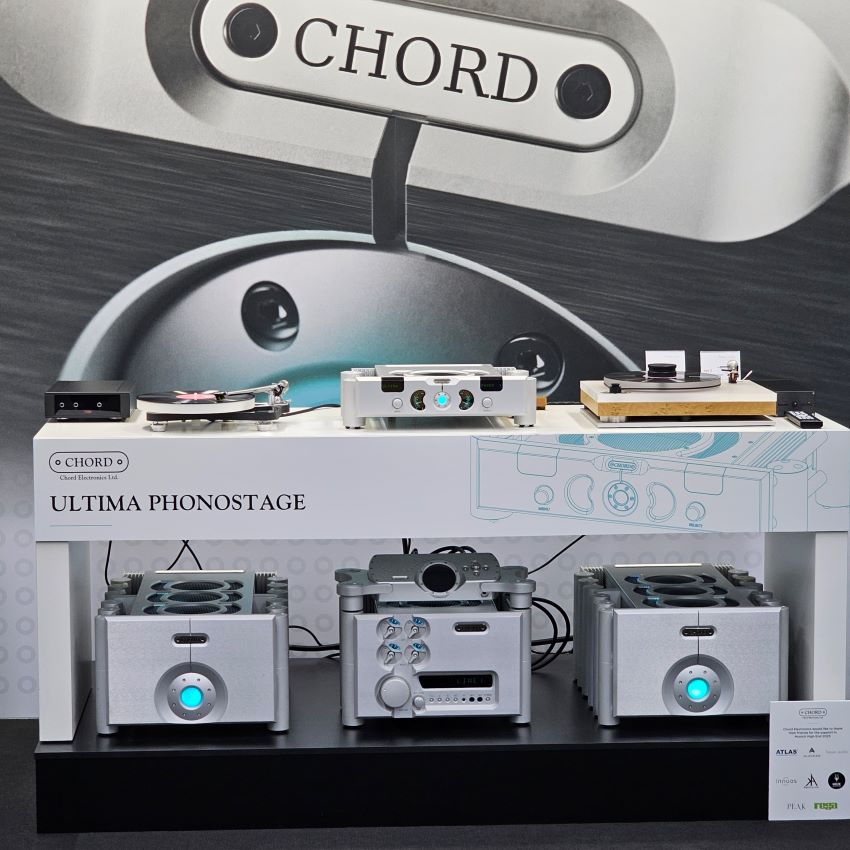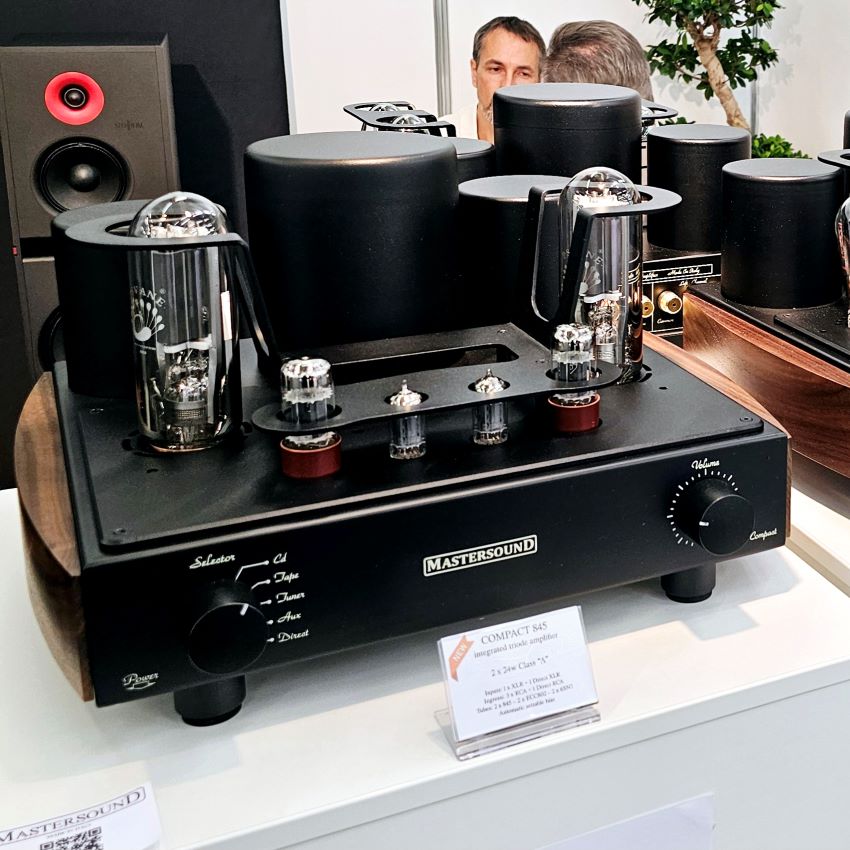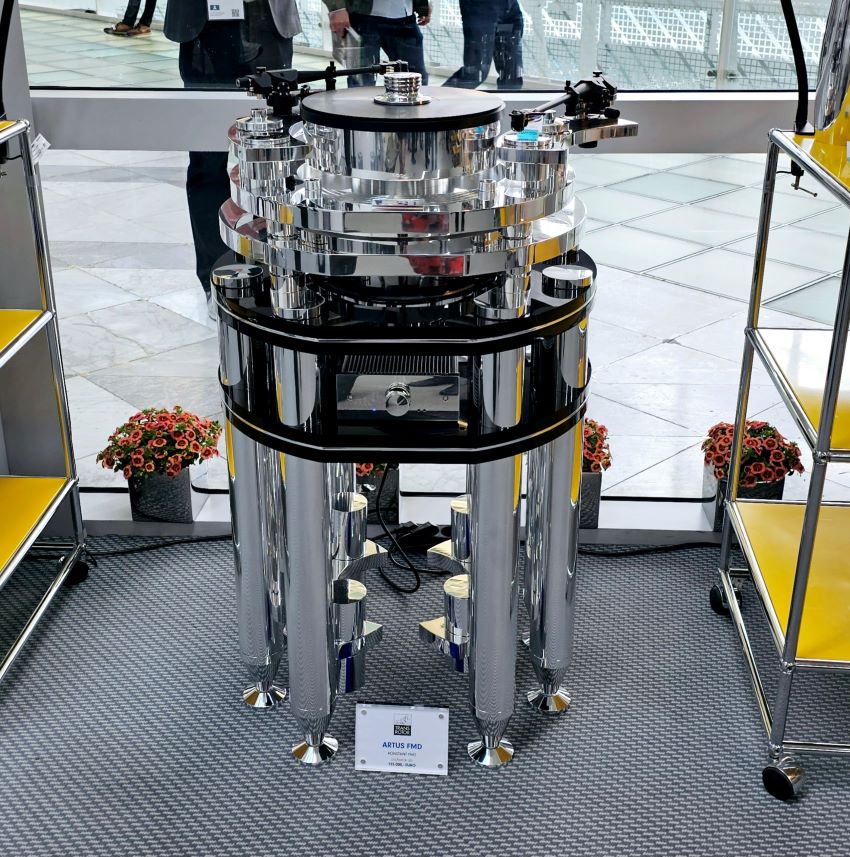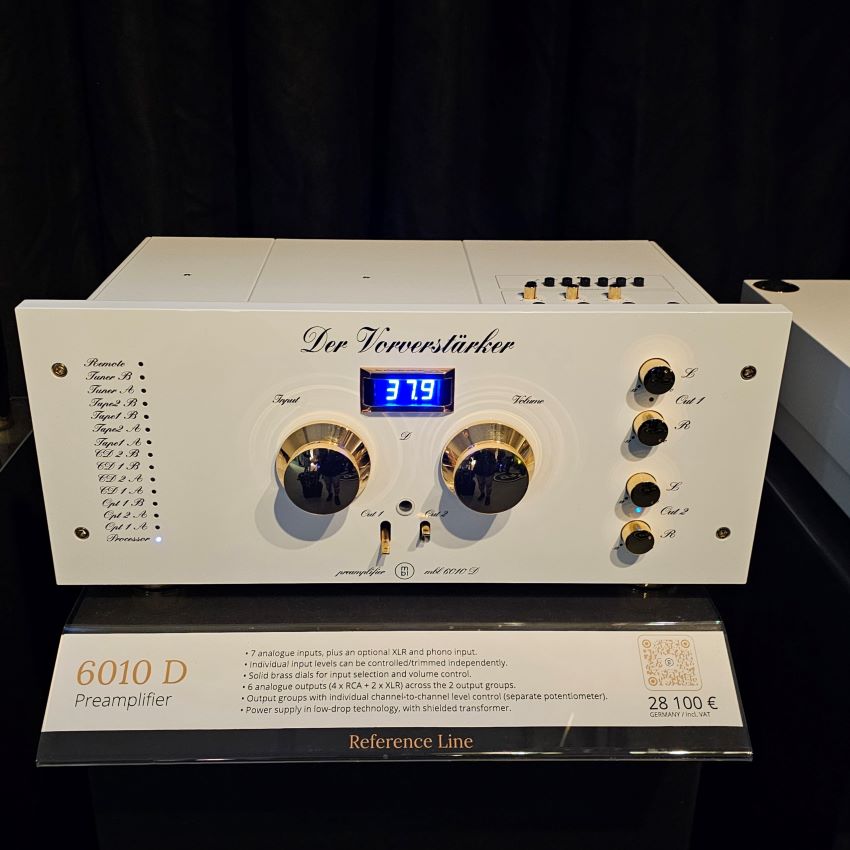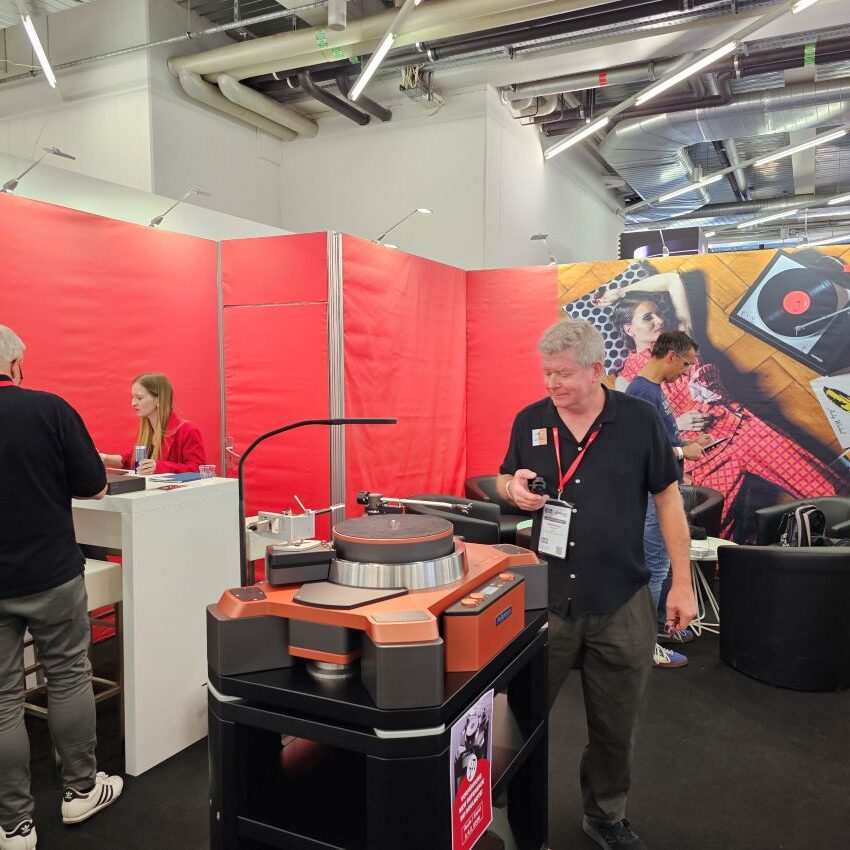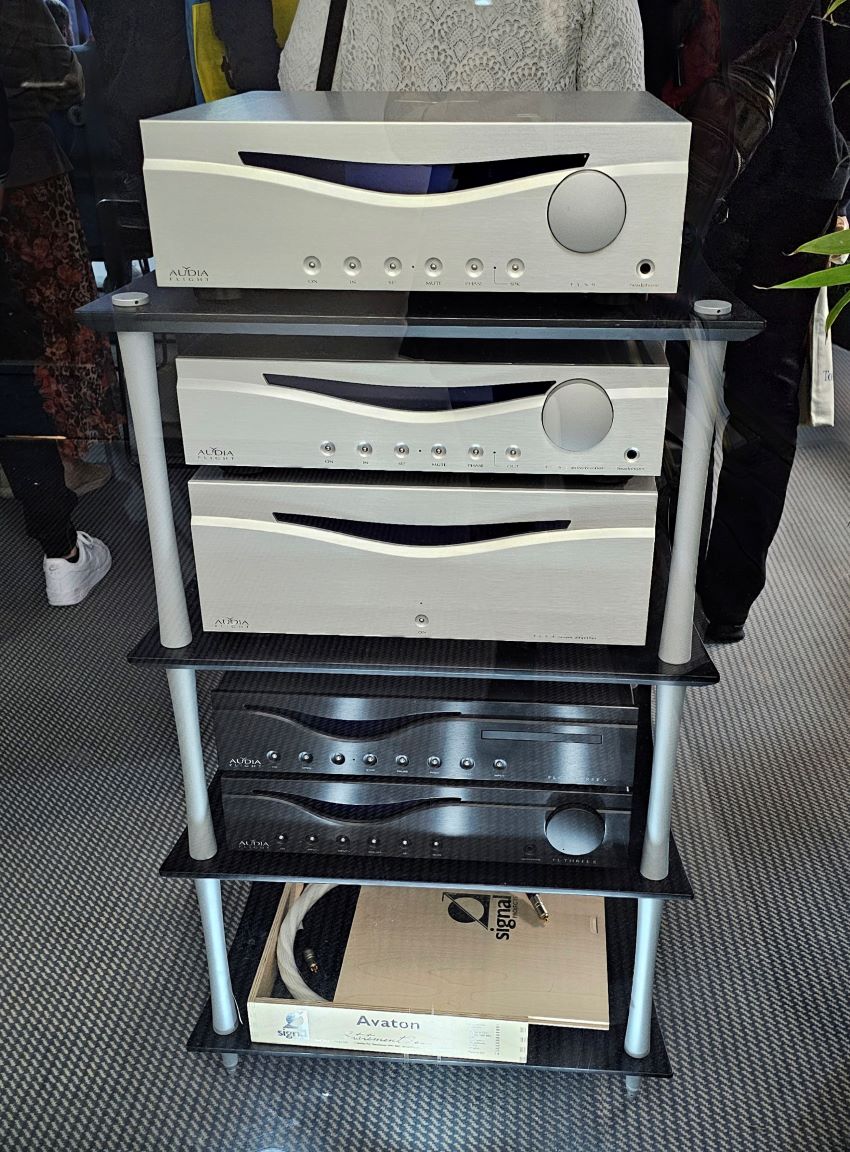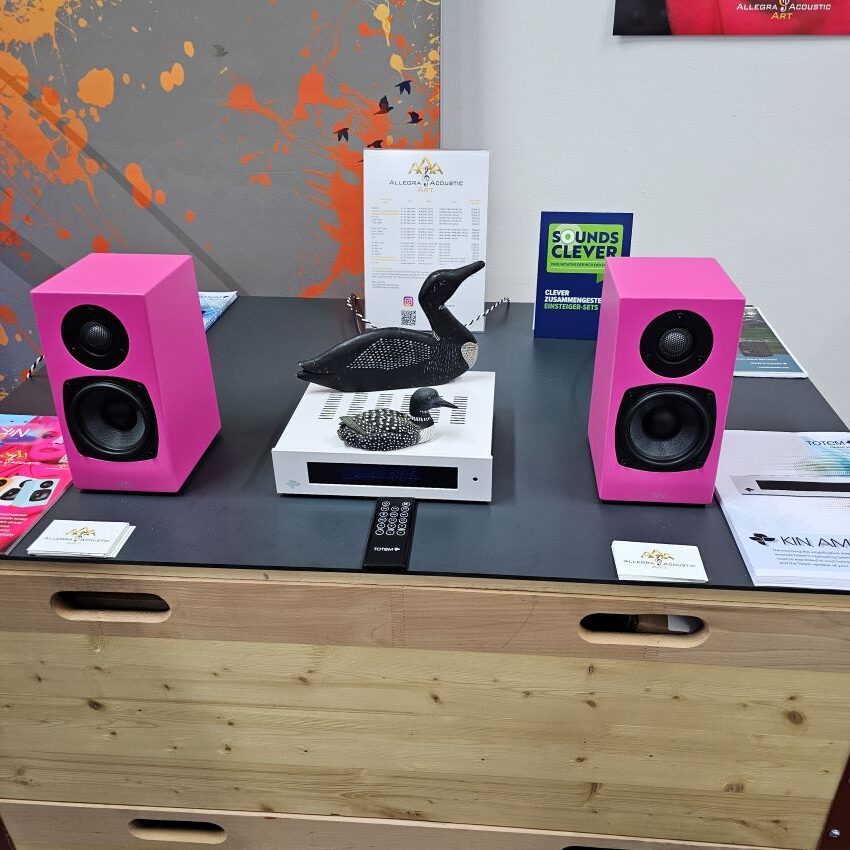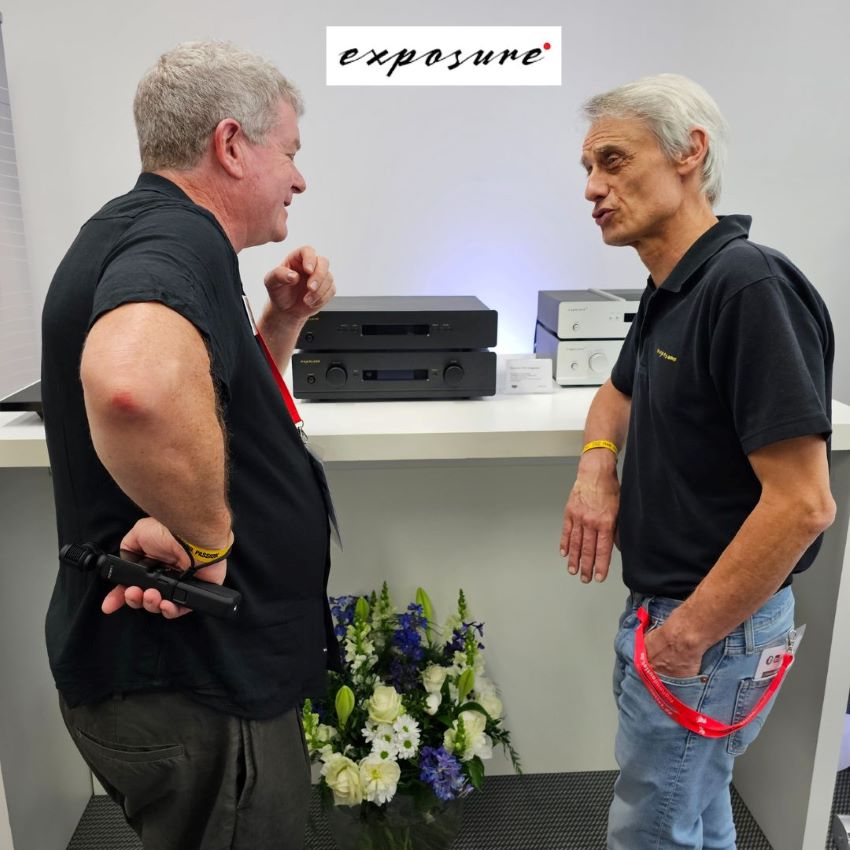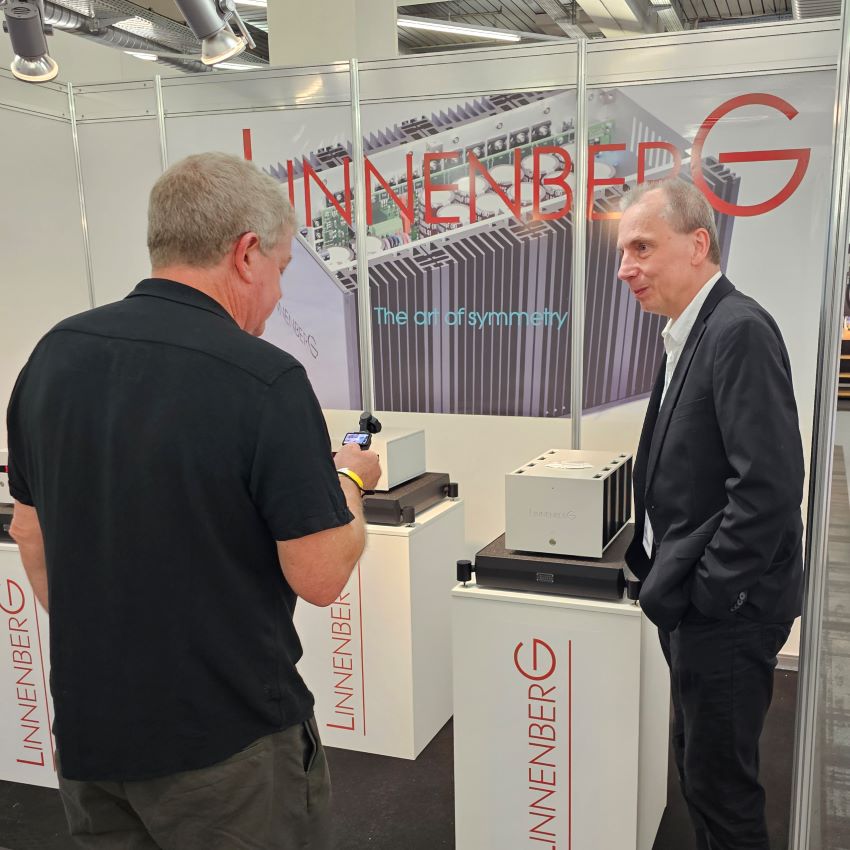Not An Audiophile – The Podcast featuring podcast episodes from the High End HiFi Show – 2025 Munich. Full interview with HiFi celebrity, Laurence Dickie who goes deep into speaker engineering and design. Also The good, bad and ugly in brands and sound. High End still offers affordability for everyone and more.
Podcast transcripts below – Episode 029
TRANSCRIPT
S2 EP029 Laurence Dickie Interviewed & High End Munich 2025, the good bad and ugly.
There are no measurable changes in running of mechanical parts
Andrew Hutchison: Burn
Andrew Hutchison: Burn in, I feel is the wrong word, but running of the mechanical parts, I feel less that capacitors have to run in. But.
Laurence Dickie: But the thing is, there are no measurable changes. Is the thing okay, somebody says, well, the suspension’s a bad time to soften up. Say, well, if the softer suspension was what we needed, we’d have put a softer suspension. And it’s the same with say, okay, amplifier running in. What’s changing? Well, the resistor values have changed a little bit. Well, Again, if a 1 point K resistor was the right value, would have used it.
Episode 29 of not an Audiophile features the Munich High End 2025 show roundup
Andrew Hutchison: And welcome Back to episode 29, season 2, not an Audiophile, the podcast. And today it’s the munich high end 2025 show roundup. And, we do an interview with Laurence Dickie, or we did one at the show and today we play it. And, he, proceeds, set me straight on a number of things that I thought were maybe true. Probably true. and of course we round up the show. The good, the bad, the ugly. there were some fantastic systems, There were some fantastic affordable systems, and there was some dreadful music. This episode of not an Audiophile. The podcast is sponsored by the Subwoofer people, Harbottle Audio. If you’re serious about subwoofers or just tired of muddy bass and bloated hype, check out Harbottle Audio. With over, 800 subwoofer configurations, they solve problems from Trinov waveforming to vintage analog systems needing an actual musical subwoofer and not some hopeless air pump. no gimmicks, just pure unadulterated bass engineered to a performance standard, focused way beyond the mundane thd versus spl. And yeah, the CEO wrote this ad. That’s how inept they are at marketing and how much they care about sound. Www.harbottleaudio.com oh, Munich High End 2025. Why do people, YouTube influencer type people, have it in for hi fi shows? I mean, it was just, it’s just a pleasure. It’s amazing. It’s a great city, great show, great equipment, lots of, you know, great people having fun times listening to and looking at a lot of interesting equipment, new stuff, old catching up with friends. I’m not sure what’s not to like. Oh, that’s right, the music. Oh, dear. please, exhibitors, just stop. It’s just terrible. but moving right along, the good, the bad and the ugly of the show.
The music is utterly effortless. It’s just warm and nice
I, I was absolutely gob smacked amazed. All of those amazing, type, Terms with the acapella, the acapella horns. I mean I might be one of the first who was going on about how good they were. But they seem to have gained some momentum and other people now realize, you know, how stunning they are. the music sort of washes over you. It’s utterly effortless. It sort of hangs in space. so much sort of inner detail. What a terrible term. But you know, there’s, there’s information laid bare, but not in a laid bare kind of way. It’s just warm and nice and I don’t know. Ah, they were playing proper music. Well, you know, I consider proper music Brick in the Wall part one. at least it’s a song and it has a melody and ah, I’ve never heard it sound anything like that. It’s just, just amazing.
So number one sound at the show Acapella, uh, by a fair margin
So number one sound at the show Acapella, by a fair margin, most expensive system at the show acapella. A fair margin, four and a half million euro, which is a new record for my ears. I’ve never heard anything like that before in that price range. But unlike a lot of equipment at the show where you go it’s, it looks cool, there’s lots of boxes and lots of fancy cables and cable support and but it sounds kind of Ho hum. the acapella is, is stunning. So as an exercise in can we make a better audio system if we throw a lot of money and great ideas at. The answer is yes. Acapella have pulled that off, but at a much more affordable price point and with some local content. local for us at least. Mark, Dohmann’s room, his turntable, some Italian tube amplifiers which I annoyingly have forgotten the brand of and yet I knew them at one point. And Cessaro horn loudspeakers, which are also Italian. I’ve never heard a piano sound quite so much like a piano. that’s what they were playing when I was in there. And the problem with this show is that there is so much to see and do. You don’t spend half an hour in a room and if you do you do it at risk of missing something else somewhere else. Although maybe I should have spent longer there because so many rooms are, are a little, you know that they’re a little ho hum. And some of the comments on our YouTube videos on not an audiophile podcast YouTube channel, some of the comments are like, oh, it’s just a show of shiny
00:05:00
bling and snake oil. Well I don’t know about the snake oil, the shiny bling. Yes. but, they’ve got a point. And that is that some systems, you know, might be half a million dollars or euros or a million dollars, and they really aren’t, you know, they’re not. Yeah, not great value for money, money not well spent. It’s not bad sound, just not good enough. I would suggest, and speaking of bad sound, Wilson Audio and d’ Agostino, that room. Wow. what a disappointment. not so much disappointment with the system because I didn’t get to hear it. It was probably amazing, but disappointment, that some auctioneer slash used car salesman just blabbed and blabbed and blabbed about how good the system was going to be when they played it. But he never got around to playing in it, playing it. At least not before I, departed the room. So that was, that was a disappointment. the other room, that was not so good. Tidal, Tidal loudspeakers. A lot of people go on and on about them as if they’re astounding. they certainly look amazing. And the Bugatti equipment that was in that room on static display also was. I mean, just probably the. Well, for me, probably the best looking pieces of equipment at the show. But we didn’t hear it. But the the Tidal loudspeakers that were playing were thoroughly, unimpressive. Sorry. just dull and uninteresting. And there’s a mid range weirdness that I couldn’t quite understand. at that price, now afford equipment. There’s lots of it at the show. Unfortunately a lot of it is not wired up. It’s static display. but, the the highlight perhaps as far as genuinely affordable gear was the Wharfedale. The new EVO 5 Series Floor Standards with Audio Lab powering them was very. I mean it was, you know, you’re not going to say it’s stunning, right? But it was very, very enjoyable to listen to and of course thoroughly affordable. A few doors away was Totem Acoustics, from Canada and for me, quite a bit better sound. Not dramatically better but. But definitely. They were playing some orchestral sort of symphonic type stuff. Stuff. Well, music. And Oh, it was, it was breathtaking. It was very, very good. In typical, typical Totem fashion. Just clean, sweet, musical, easy to listen to. I, don’t know, just, Just an utter delight. not sure why. Totem’ spoken about more. Also great rooms. Esoteric Audio and Mar10 loudspeakers, was, was a pleasure. we’re jumping away obviously from the affordable there to the definitely not so affordable. Although compared with other systems at the show, I guess this one was only a couple of hundred grand. Right. total deck also amazing. And Tad, genuinely a delight as well. So that’s, that’s that we listen to lots of other equipment. To be honest, most of it probably isn’t worth mentioning because it was good but not great. You really have to go and listen yourself. and I would also say as a caveat to those rooms that I didn’t get excited about that. Different music at a different time with a different amount of people and a different amount of ambient noise and maybe on a different day when they maybe have tweaked the system a bit or changed something to improve it could well add up to a more enjoyable demonstration. I guess. It’s a moving feast in the sense that that show in the sense that I would guess and knowing from my own exhibiting experience the system can improve over the day simply because you try things that evening to improve it and sure enough get a better result for the next day. show overall.
Visit stereonet. com to join one of the world’s largest online communities
Well, probably the best thing is what we’re going to play now. And that’s a chat with Laurence Dickie. he sets me straight on a few things that I thought were truths about audio. And he’s an enthusiastic and generous, lover of the hi fi industry. he loves making great equipment and giving people pleasure listening to music at home. And it’s quite clear from his demeanor. So without any further ado, Laurence, looking for your tribe? Visit stereonet.com today. Join one of the world’s largest online communities for hi fi home cinema headphones and much more. Read the latest news and product reviews or check out the classifiers for the largest range of gear on sale. Membership is absolutely free. So visit stereonet.com and join up today.
Laurence Dickie says shape around loudspeakers is essential
Andrew Hutchison: So we’re delighted at not an audiophile today to speak to Laurence Dickie. He says he’s the most famous loudspeaker designer in his. And I actually in my research of your career, which I’ve done for me. No I haven’t but I have looked around and as much as you like to make light of certain things that you’ve done, you’ve actually done some incredible work. I mean like very like cutting edge, lots of research and, and I guess I mean what I really want to talk to talk to you about today is the boring things like cables and cone materials and box enclosure materials, which. Because you. I
00:10:00
Andrew Hutchison: mean the shape of the, of your current range, the vivids. Very organic.
Laurence Dickie: Yeah, I mean it is that shape for a reason. ultimately the shape of the box around the high frequency units in particular does have a real significance. It’s the effect it has on diffraction and interference. You know, it’s important. And the smooth shape around the tweeter is essential. Whether you carry that smooth shape on around the rest of the body is a little bit more, artistic license.
Andrew Hutchison: So less, less critical at lower frequency.
Laurence Dickie: Oh, yeah, yeah, yeah. I mean like, you take the gear which has this very organic single swirl on the top. In fairness, that could be a zigzag.
Andrew Hutchison: You could just. That could be a zigzag. I’m gonna say you could just hack saw it off, but.
Laurence Dickie: Oh, no, no, no.
Andrew Hutchison: It does actually, because it’s one of your tapers, your patent. Not patented. Maybe M by that is. It’s a tapered, it’s sort of resonance reducing cap enclosure.
Laurence Dickie: Exponentially tapered.
Andrew Hutchison: That’s the word I was looking for. Exponentially tapered.
Laurence Dickie: Yes. Yeah. Of course, the original came. Came out on the northwest, and it works very well just sticking it directly on the back of a driver. But the as it were inventive step with, with gear was to combine the taper tube with bass reflex, which we certainly hadn’t done before. And that thing was actually patented because, that combination getting just the right taper, which absorbs the resonances but doesn’t take away the port energy was. Yeah, that was actually quite a step forward.
Andrew Hutchison: So. So yeah, just for clarification. So that Exponentially. Da, da, da. That is actually the whole enclosure volume inside the reflex enclosure.
Laurence Dickie: Yeah. And in the gear.
Andrew Hutchison: Yeah.
Laurence Dickie: The whole chamber volume for the base units is what you see. And then at the top it blends smoothly into this exponential curled exponential horn. Now as I say, it doesn’t have to be curled. And in fact, in our later products, the Kayas, there’s a sort of hairpin bend at the top of the cabinet where the.
Andrew Hutchison: I say there is.
Laurence Dickie: Yes, but it’s still in there. The exponential taper is still in there. It’s ever simple, but it really works.
Andrew Hutchison: I mean, it’s for the sake of an open and honest conversation. Let’s face it, it has to look good as well.
Laurence Dickie: Look, there’s no question. a loudspeaker is a sculptural object. Whereas really all the other bits of electronics and stuff you could hide away if you felt that way. Yes, but clearly the speaker has to be more or less visible.
Bowers’ curvaceous loudspeakers divide opinion
Having said all that, of course, with custom install, which is a completely different world and there is, you know, people in fact want to make their speakers invisible. I just don’t get that myself. For me, a speaker is, you know, the joy of it.
Andrew Hutchison: Well, it’s a furnishing item to some degree. It’s a piece of, of. It’s a piece of art, you know. And yours, yours obviously take that to a level much higher than most.
Laurence Dickie: And I’ll be honest, they do divide opinion. It’s always been the same with our products going right back to the mid noughties, when we were first exhibiting the B1, in the UK.
Andrew Hutchison: Yes.
Laurence Dickie: And in the morning we had this Italian lass who came in and she fell to her knees and started stroking the speaker going, oh Bella. Which was really lovely. It is really. But then later in the same day, on the same day, ah, these two women came in and one said, the other in a not discreet way, says, my God, they’re ugly. I could never have those in my home.
Andrew Hutchison: It’s a world of contrast, isn’t it?
Laurence Dickie: Yeah, really now. But I’ll tell you, on that day, the worst thing that happened was I was stood outside the room, as you do, to just get a breather. and these two guys in anorax walked by and paused briefly, looked into the room. And then one says to the, you’ve seen one, you’ve seen them all. I thought, now that’s rude.
Andrew Hutchison: That’s actually rather bizarre because I realized what they were looking at M. Because I mean there actually is. I don’t think there’s any other. There’s been a few curvaceous loudspeakers over the years. They’ve never quite pulled it off.
Laurence Dickie: No, there are more and more.
Andrew Hutchison: And I think when I saw yours first, I’m like, oh, I’ll see how they, you know, how will this go? But having heard them over the years, I mean, you know, at the end of the day they do perform very well. And there is.
Andrew Hutchison: And there is.
Andrew Hutchison: Well, but they do. And they’ve got a, I mean they have that kind of hear through sort of sound. They’ve been. I did see one video where you’re talking about coloration and I mean you’ve clearly reduced that. Even though it’s vivid, it’s vivid. The sound is kind of vivid because There is no coloration.
Andrew Hutchison: No, absolutely.
Andrew Hutchison: I mean, that’s the way I feel about it.
Laurence Dickie: I’ve always drawn that analogy with the window onto the performance. And obviously the purpose of the speaker is to give you a window onto the performance of the artist. We are just an in between stage.
Andrew Hutchison: You do want to add. I always feel there needs to be a pleasant color though. I mean, you wouldn’t. You don’t want a studio monitor. Some people do. I personally, I want to sort of. Now you also work in the pro audio world, so do you see the clash of the, of the, businesslike nature of pro Audio?
Laurence Dickie: Yeah, look, there’s a clash, it is a clash of the. In the business side of the thing. There is or should be a huge overlap in terms of actual engineering. We’re sort of. I guess there are really.
Andrew Hutchison: Acoustics don’t change, but the priorities in the design do.
Laurence Dickie: I. Yeah, the difference, of course, in pro Audio. And it depends, you know, whether you’re talking about front of house, you know, large pa.
Andrew Hutchison: Yes. Yeah.
Laurence Dickie: or studio monitor professional. studio monitors are very much big. Hi fi. And in fact, in fact, when I started, when I left Bowers, it was because I wanted to get into, making studio monitors and the drivers that I developed in that time before joining Philip in South Africa, I designed with the intention of bringing the Nautilus type quality of sound to studio levels of sound. But, I also really had a fascination with large scale, sound reinforcement. Yeah, it’s all well and good. I mean, one geezer sitting there tapping his fill, going nice, but if you can.
Andrew Hutchison: Oh yeah. I mean that’s, that’s the real deal, isn’t it? In the same way as that, that emotion that, that you get in a big stadium just from having a performance or a band there and the whole crowd is getting off, but to be responsible for the sound.
Laurence Dickie: Yeah, yeah. No, it’s a buzz. And you know, obviously those kids don’t give a damn. But you can sit there and say that’s my tweet of that is.
Andrew Hutchison: Well, I think, I think they kind of do in a way. I mean, if it was dreadful, you know, and some. I have to.
We could talk about pro audio more than domestic in some ways because I have strong feelings that pro audio’s fidelity wise. Is it just me or has it gone backwards slightly because it’s more convenient to make lighter boxes and things? Or is that, Is that a. Is, that going too far?
Laurence Dickie: No, no, I think that’s going too far as always. The main thrust to, you know, the.
Andrew Hutchison: Talking front of house.
Laurence Dickie: Yeah, exactly. yeah, no, sure. the most important factors are ah, you know, ease of use. People want to be able to get in and out of the venue quickly. Smaller, and lighter.
Andrew Hutchison: Well that’s never been better, has it really?
Laurence Dickie: No, no. The point is that sound quality tends to come a little bit further down the list of priorities. Oh, directivity, that’s super important.
Andrew Hutchison: Yes.
Laurence Dickie: The pattern control, being able to put the sound where you want it and not where you don’t want it. and those tend to be perhaps a little bit more important than just the pure fidelity.
Andrew Hutchison: Well that’s perhaps what I’m referring to is that that directionality directivity has been improved dramatically, hasn’t it?
Laurence Dickie: Yeah, line arrays are very effective in that respect. but you know we audio engineers do try to sneak, sneak the quality in.
Andrew Hutchison: Well of course you do.
Laurence Dickie: And now actually obviously it depends on the engineer as well I think. Melbourne Pierce. So the line arrays pretty good. Yeah. Good liner rack.
Andrew Hutchison: I’ll blame my local venue then more than the equipment. Then I’ll blame the ah, engineering team.
Andrew Hutchison: I was just talking to Jeff at Haynau hi Fi, about his latest installation. Another dome and turntable this time one with a supertrack Blackbird arm and a Mutek Hayabusa cartridge. Motorcyclists everywhere are wondering how that could be. Blackbird army. cartridge. Yeah. anyhow then he was said he was going back to the store to listen to some records on the Helix 2 in store unit. I thought do you ever get sick of listening to records? But then maybe not playing them back through the Fisher and Fisher speakers that are ah, crafted from slate.
There is a temptation with line arrays to try and get away with
Anyhow, enough discussion of Jeff’s antics back to the show.
Laurence Dickie: There is a temptation with line arrays to try and get away with effectively just a tweeter and a cone base mid.
Andrew Hutchison: Yes.
Laurence Dickie: Where really you do need to have something in between. and a line of race should be a three way box at least to make it work properly. But there are far too many two way boxes and the compromises that are made by having compression driver, just one compression driver going all the way from I don’t know, one and a half K up to 20.
Andrew Hutchison: Yeah.
Laurence Dickie: And then a pair of 12s going up to. There are too many compromises.
Andrew Hutchison: Yeah, yeah, yeah.
Laurence Dickie: So yeah, that is a bit of a problem. Yeah. Okay. Yeah, okay. That’s just economics.
Andrew Hutchison: I’d say it’s more like more my, my narrow band of Experience Coming Back to hi Fi, though.
Laurence Dickie: Yeah.
Andrew Hutchison: So if you were, say in 10 or 20 years time when you’re not working anymore and you’re relaxed.
Laurence Dickie: I can’t even imagine that in your.
Andrew Hutchison: Little, your little,
00:20:00
Andrew Hutchison: ah, humble provincial French chalet. Chalet.
Laurence Dickie: I like this dream.
Andrew Hutchison: Well, you know, maybe it’s not a dream, but. Oh, you’re, you know, I don’t know, you’re in Durban on the beach. I don’t know where you are. But the point is, you, you’re relaxed, you’ve. You’ve sold the business for gazillions of dollars. And your brain is still, of course, ticking over.
Laurence Dickie: Yeah.
Andrew Hutchison: And you feel like you want to build a pair of speakers for yourself.
Laurence Dickie: Yeah.
Andrew Hutchison: There are loudspeakers for your own personal use. Is it asking too much to have you sort of allude to what they might be? Because, I mean, you’ve done. You’ve listened to so much stuff, you designed so much stuff. You must have personal use.
Laurence Dickie: You know, that’s kind of already.
Andrew Hutchison: Is it.
Laurence Dickie: That’s what it is. That’s the embodiment of my personal state of the art.
Andrew Hutchison: Yeah.
Andrew Hutchison: So something that, that is, that is capable of playing very big, very loudly, very cleanly.
Laurence Dickie: Yeah, absolutely. Absolutely. At the moment, I can’t, I can’t think of a, of a better, of a better product, if I’m honest. I can make it bigger, but.
Andrew Hutchison: You could make it bigger.
Laurence Dickie: That’s really it. That was the big step between, our former top of the range, the G1s.
Andrew Hutchison: Yes.
Laurence Dickie: And was. Well, initially it was just making it bigger.
Andrew Hutchison: Well, you did that.
Laurence Dickie: And in fact, almost incidentally, we ended up making it better as well, which is.
Andrew Hutchison: Well.
Laurence Dickie: Well, yeah.
Andrew Hutchison: Yeah, yeah, yeah.
Andrew Hutchison: I have to say I haven’t really. I don’t feel I’ve heard them at their best. I’ve heard them here last year or the year before. you had them in a small room in the halls. And, they, they made a very nice sound, but the room was almost no bigger than the loudspeakers. And is that a problem?
Laurence Dickie: Is that the G1s or the mo.
Andrew Hutchison: The moya.
Laurence Dickie: Oh, yeah, that was here last year.
Andrew Hutchison: Yeah, yeah, yeah, you’re right.
Laurence Dickie: It was a. One of these little listening booths. Yeah. I mean, it’s not, it’s certainly not ideal.
Andrew Hutchison: Ideal.
Laurence Dickie: The best setup I’m aware of at the moment, is with bill Parish, our U.S. distributor.
Andrew Hutchison: Yes.
Laurence Dickie: he has a beautiful listening room. It’s about, 10 meters by seven.
Andrew Hutchison: Yes.
Laurence Dickie: Probably about three and a half tall. It’s an ideal perfect space. That’s a really lovely space. And he’s got them set up so well. Yeah.
Andrew Hutchison: And do you.
Laurence Dickie: Okay thoughts.
Andrew Hutchison: What sort of front end do you need to get the best. I mean they’re not, they’re quite sensitive I presume.
Laurence Dickie: Yeah, they are reasonably
Andrew Hutchison: So they don’t in theory they don’t need them.
Laurence Dickie: No. That’s the irony. It the bigger the speaker the less amplified. People obviously have this instinctive assumption that you’re going to need a big amp, big speaker, big amp. Of course it’s the other way around. So. Yeah.
Back in the 90s when I was quite interested in larger sound systems
Ironically the Moyas probably get a pretty reasonable amount of sound with a single ended 25 watt triode.
Andrew Hutchison: Yeah, well that’s, that’s ah. Kind of. Well that, that or you could put a musical fidelity A one on there. An actual. Actually it would play quite loud but in fact the amplifier could warm the room up if you’re in a cold climate.
Laurence Dickie: That happens. Yeah. But in fact because people end up putting I don’t know 800 or 1200amps on these things and.
Andrew Hutchison: Yes.
Laurence Dickie: And then it rots of course.
Andrew Hutchison: Unlimited headroom.
Laurence Dickie: Wow. Yeah absolutely. Or club like sound levels which is fun. You can have a party with a pair of Moyers for sure. Yes, yes. They actually Back in the 90s when I say I was quite interested in larger sound systems I was still Bowers and Wilkins and we we were into the whole rave scene in the UK and putting on parties and I had a funny little sound system which was built with Bowers and Wilkins drivers and the
Andrew Hutchison: Found lying around, around the factory very kindly.
Laurence Dickie: My boss Robert was Robert Trims was quite supportive in this because he also thought the idea of having BMW Pro would be rather fun. So anyway we took the 12 inch drivers from 800 1s and stuck them in the end of the Ends of cardboard tubes. Oh yeah. Stack them up like barrels. and it was actually quite a nice sound system. It was never allowed sound system but it had a hi fi quality anyway. I’ve never forgotten the sound that we had with that. And whilst it wasn’t the route to Moya, the route to Moya is you know well recorded in other places. But having assembled this thing with eight, eight bass drivers in it I thought yeah actually that’s. That’s kind of reminiscent of that PA we built back in well literally 30 years ago. and indeed it has some, some of that effortless bottom end Quality even at sort of club levels. And it’s fun. You know, that’s the thing about this. We never forget. It’s.
Andrew Hutchison: We got you on video saying exactly that the other day. And I mean, I couldn’t agree more. I mean there’s all, there’s all kinds of kinds of fun in this business. But I mean listening to music and having it. Have some sort of like having it sound like a band, having that sense of scale. As much as I love LS35
00:25:00
Andrew Hutchison: as. I mean for what they do in a small space at home, in an intimate moment late at night, they are not, they can’t do. They can’t make real music. Not really. Not even the sense of scale of a cello or something really.
Laurence Dickie: We must never forget that a decent tune will sound good even if you play it on a music box. That’s the power of the art, if you wish. But the experience of the texture of the instruments and indeed the scale of the performance.
Moya gives you a sense of the scale of the auditorium
And that’s the other thing about Moya which ah, it shouldn’t have come up as a surprise, but it kind of did anyway. This perception of the scale of the auditorium. Obviously it’s an acoustic recording that you get a sense of space and the weird thing. And you know, people elsewhere have made this observation. I’m certainly not the first but when you sort out the bottom end of a sound system, weirdly it sorts out the perspective of the whole range so it actually places the higher frequencies in the environment. It’s a weird old thing.
Andrew Hutchison: It does. In my experience. I could only agree but luckily I don’t wish to argue. But yeah, that is a thing, isn’t it? You get the base right and then you kind of. The rest follows. But is there, is that a brain perception thing? Is that something going on in the acoustics of the space?
Laurence Dickie: I think no, I mean it’s an acoustic thing is that To hear a large space you need to hear low frequencies because clearly they’re affected by The dimensions of the auditorium, will affect lower and lower frequencies as the space.
Andrew Hutchison: And I guess part of the difficulty of creating a so called live experience with a With a hi fi system is. Is that dynamics and that scale of sound which you really can only get in a bigger room. I suppose we all know when you walk into an auditorium and they’re either. They’re just playing the backing music to get the. Before the gig starts straight away there’s a sense of a. There’s a sense of the sense of space yeah. Of the acoustics. There’s a long decay time, but a controlled one. But then there’s that bottom end, that genuinely deep ease also in the bass.
Andrew Hutchison: Yeah.
Andrew Hutchison: Which is clearly what you tried to get with Moya.
Laurence Dickie: There is an interesting thing with, Here thinking of classical concerts before the orchestration starts playing. And in particular, if they’ve got, Quite a bouncy hollow stage or.
Andrew Hutchison: Yes.
Laurence Dickie: some performers are on risers boxes. And, you know, they’ll drop a music stand or just shuffle their chairs or something. And they’ll make a deep noise.
Andrew Hutchison: Yes.
Laurence Dickie: And that’s. Well, just like that. Yeah. Somebody dropping a program. And you hear the way that the sound reverberates in the space. And even before the band started playing, you get a feel for the space. You know, somebody coughs over there, and you just know the environment that you’re in.
Andrew Hutchison: And it’s all a bit special, isn’t it? Because it’s. Well, it’s special because I guess you can’t experience it almost any other way.
Laurence Dickie: Yeah.
Andrew Hutchison: Yeah.
Andrew Hutchison: And that’s what hi Fi can’t do.
I believe that drivers should operate pistonically in their pass band
But getting back to your dream speaker system, which you’ve already built.
Laurence Dickie: Yeah.
Andrew Hutchison: But let’s say you had to build a smaller one. Do you. I mean, in your BMW days, you must have experimented with cabinet materials a bit and I guess comb materials. But I’m not sure that you had much to do with the choice of Kevlar. Although.
Laurence Dickie: No, no. Kevlar preceded me. Yeah.
Andrew Hutchison: But you quite get along with that.
Laurence Dickie: No, I’m quite adamant about this. I believe that, drivers should operate pistonically in their, pass band.
Andrew Hutchison: Okay.
Laurence Dickie: And that, Unfortunately, I don’t think it’s possible to properly terminate, a cone driver. for instance, you know. So you’ve got a voice coil attached at more or less the apex.
Andrew Hutchison: Yes.
Laurence Dickie: And a, surround around the edge. And the hope is that as the transverse wave propagates up the cone, you absorb it at the edge with, the surround.
Andrew Hutchison: Yes.
Laurence Dickie: Well, you can’t do that at all frequencies. It’s quite pretty much. So there will therefore always be. Assuming it’s a, floppy cone, as in Kevlar or plastic or paper. there will be resonant modes, and they tend to be in the sort of kilohertz and up. And they give the cone a character. A character. And that. That is something that was really the thing. No, no, it can be. Oh, yes. A bit. You know.
Andrew Hutchison: But it’s not accurate.
Laurence Dickie: No, no. The loudspeaker as the musical instrument. Yeah, of course, cone character is perfectly acceptable. And indeed, you know, the classic sound of a Marshall 4B12. It’s split between the overloaded tube and these floppy paper cones cracking up and the two together make, make music. Awesome music.
Andrew Hutchison: Yeah.
Laurence Dickie: but, but in studio monitor. Well, yeah, monitor, loudspeaker. I always think the word monitor to me means a loudspeaker which adds nothing to it.
00:30:00
Laurence Dickie: Again, it’s for you, it’s as trans.
Andrew Hutchison: Monitor as possible.
Laurence Dickie: Yeah, yeah.
Andrew Hutchison: Literally hear what the electrical signal is, I guess.
Laurence Dickie: Yeah. So to that end, I’ve always believed that drivers should behave historically and go to over effort to make sure that the breakups are as high and out of band, as possible.
Andrew Hutchison: An Australian loudspeaker legend has been born with the stunning new VAF Research i93 Mark V, winner of Stereonet’s floor standing loudspeaker Product of the year and Sound and Image magazine’s Floor Standing speaker of the year, 20,000 to $50,000. VAF’s i93 has redefined what I thought was possible from a loudspeaker, in a domestic setting, says Stereonet VAF Research Building Award win speakers in Australia since 1978.
Fiberglass cones have better breakup performance than aluminum cones
Andrew Hutchison: So we’re back with Laurence and we were talking about floppy cones and no one wants a floppy cone. Well, they don’t. Well, you certainly don’t because you’ve just stated that you kind of don’t believe in it. So you’re a fan of sort of multi layered cones. Well, when you want them to be infinitely light, I guess, and infinitely stiff. Is that the thing or not?
Laurence Dickie: Oh, okay. Yeah, well, in an imaginary way. Okay. Yes, it’s the ratio between density and stiffness is crucially important. And so, metal cones, have a better, better performance in that respect. Which means that their breakups, it’s, it’s quite easy to get the break makeups usefully, out of band.
Andrew Hutchison: Yes.
Laurence Dickie: There is a thing I should say here is that somebody just the other day was asking me, okay, you’ve got aluminum cones, can you imagine anything, better? Well, yeah, of course. Beryllium cones, yes, would definitely be better. The breakup frequencies will be roughly double those of the. Oh, yeah, yeah, yeah. It’s a very significant jump.
Andrew Hutchison: But they would be unmaked.
Laurence Dickie: No, no, no, Tad, of course, famous for their beryllium cones. Don’t get me wrong, they completely work. But the thing is that, there’s more than just the breakup performance of the cone to consider here. There’s also the dispersion. Now if you’ve got a 100 millimeter cone by 3 kilohertz, it’s.
Andrew Hutchison: Well, narrows that.
Laurence Dickie: Yeah, it’s about six or nine decibels down at 90 degrees off axis. So it’s really beginning to be.
Andrew Hutchison: Yes.
Laurence Dickie: So you’ve got to cross over. You can’t possibly take that driver much higher. You’ve got to cross over. And really you should have crossed over and opted below so like 1 1/2 kilohertz, something like that. so really if you can have your breakup a couple of octaves above crossover, you know, if you cross over is one and a half cat. Well that’s, that’s easy. Break up at 6K is easy even in aluminium.
Andrew Hutchison: And, and using electrically what, third order filters is kind of.
Laurence Dickie: Yeah, we go for fourth linguists Riley fourth. It’s a classic sort of alignment and it works for us. and you know, it means that the drivers are absolutely in phase through crossover.
Andrew Hutchison: Yes.
Andrew Hutchison: and all of that, the nasties are attenuated quite dramatically.
Laurence Dickie: Yeah, yeah, yeah, yeah, yeah. Absolutely. Adequately. so yeah, what I’m saying is that in a way we don’t really need anything better than relatively humble aluminium entertaining all magazines.
Andrew Hutchison: So it’s kind of a non conversation at this point. You don’t spend a lot of time on it because you’ve kind of. Obviously you’re happy with that and you’re happy with fiber.
Laurence Dickie: Fiberglass
Andrew Hutchison: It’s, it’s. I mean I feel like it’s an ideal material except no. For a cabinet. Moving sideways to cabinets. Yeah, no, no, we don’t want a quarter inch thick fibreglass comb. But it, I mean it’s, it’s such a mongrel of a material to work with. But you’ve worked around that by how you go about manufacturing it and where. I guess. But I mean it’s got to be a pretty good material for equipment.
Laurence Dickie: It’s excellent. Actually. We, we use vacuum infused composite sandwiches, $5 sandwiches. So we got a low density core. in the past we’ve used end grain balsa. There a bit of a shortage of end grain balsa because it’s being used in wind turbines in huge quantities. but, sorry, who’s using it in huge quantities? The wind turbine really.
Andrew Hutchison: For the blades.
Laurence Dickie: Yeah, yeah. So the Chinese.
Andrew Hutchison: Well, they would be using a lot.
Laurence Dickie: Yeah, yeah, obviously. so we’re currently using foam, a synthetic foam material which actually you’re okay Works incredibly well.
Andrew Hutchison: Yes.
Why don’t you use carbon fiber for your speakers? Simple answer
Laurence Dickie: now, of course one of the questions that people have asked me on numerous occasions over the past is, hey, we see you use glass, glass fibre composite. Why don’t you use carbon fiber?
Andrew Hutchison: Uh-huh.
Laurence Dickie: And my answer to that is very simple. If we were chucking this thing into space.
Andrew Hutchison: Yes.
Laurence Dickie: Then we’d use carbon fiber because weight would clear. Because the absolute weight is important. Or if it was a racing car or something where the absolute weight is important. But we’re bothered about resonant structural modes, in the
00:35:00
Laurence Dickie: case. And a beam of materials with two stiff skins and a low density core will have a, A resonant frequency. you can stiffen the skins to push that resonant frequency up or you can thicken the core.
Andrew Hutchison: Yes.
Laurence Dickie: And the thing is that
Andrew Hutchison: So thickening the core will raise the resonant frequency.
Laurence Dickie: Yeah, it increases the stiffness of the structure without changing the mask. Hardly changes the mask. So, so for us the performance of a glass fiber, enclosure material is actually completely adequate.
Andrew Hutchison: It’s not just adequate, it may be advantageous in a way. Is it because of where you perhaps desire to put your resonant frequencies of the enclosure? It’s literally all you need and it’s about a tenth of the price, I guess.
Laurence Dickie: Yeah, absolutely. But with Moya, we have put carbon fiber skins on the, on the in and outside of the. Of the box because, because we can, we can.
Andrew Hutchison: And it looks lovely.
Laurence Dickie: Well, it looks. But of course we actually, we end up painting all our speakers anyways.
Andrew Hutchison: There’s some little feature panels somewhere. Is there on my thing.
Laurence Dickie: Oh, there is a, the, the absorber at the back. I believe, we can leave that raw.
Andrew Hutchison: Yes.
Laurence Dickie: and have done on certain examples. It looks pretty cool. especially if, obviously if it’s a dark color.
Andrew Hutchison: Yes.
Laurence Dickie: it’s quite natural. Yeah. Yeah, that does actually look pretty cool. But Yeah, otherwise it’s another, Another well kept secret.
Andrew Hutchison: It’s a funny material like carbon fiber, isn’t it? You see it a lot in, on automotive interiors and I’m pretty sure it’s not required in the slightest.
Laurence Dickie: The stuff on automotive. Well, it’s interior.
Andrew Hutchison: It’s probably.
Laurence Dickie: It’s looky likey.
Andrew Hutchison: Looky likey.
Laurence Dickie: Yes, yes there are. And you can get vinyl wraps which look like carbon fiber.
Andrew Hutchison: And unless you’re I guess, driving for McLaren or something where it probably is real carbon fiber.
Laurence Dickie: Yeah, that is real.
Andrew Hutchison: But your steering wheel is presumably made from.
Laurence Dickie: I think it’s proper. Seriously?
Andrew Hutchison: Yes, yes.
Laurence Dickie: There is another place where we’ve been using carbon fiber for the whole history of Vivid Audio, and that’s around, tweeter domes. and there, it’s vital there, we couldn’t possibly replace it with glass. Yeah, that is a little ring of, just two turns of thousand toe super high modulus carbon, which radically changed the performance of our domes.
Andrew Hutchison: Okay.
Laurence Dickie: It is a really crucial part of Vivid Audio, as I say.
Andrew Hutchison: So this is in the drive unit itself.
Laurence Dickie: Yeah, that’s the, the D50 and the D26, the 1526 millimeter dome drives, they have this, special shape. It’s a catenary. and it’s the combination of that special centenary shape with this peripheral carbon fiber stiffener doubles the first breakup frequency. So you know it.
Andrew Hutchison: Wow.
Laurence Dickie: Yeah, doubles. It does, yeah. So when.
Andrew Hutchison: So that sends it way out of the audible range.
Laurence Dickie: 40 plus kilohertz. And right back at the beginning of Vivid Audio, my old mates at Bowers and Wilkins had just started using the diamond domes.
Andrew Hutchison: Yes.
Laurence Dickie: And so I called De Beers and the other lot in Germany. Fraunhofer Institute.
Andrew Hutchison: Yeah, yeah.
Laurence Dickie: You know, can we have, can, can we see some of this diamond action? It was pretty cool, but they had exclusivity deal. So, that was a bit annoying. But then afterwards I thought, you know what, Sod it, we actually achieve a pretty good result with our funny, shape dome. And the carbon fiber. You know what we’ve got, we, we have absolutely adequate performance. 40 something kilohertz. Oh, that’s is nothing to stifle, you know, it’s fine.
Do you have feelings on that that humans don’t really hear
Andrew Hutchison: Do you have feelings on that that humans don’t really hear? I mean, some people, you know, they talk about was, it super audio CD or back in the day it was like. Or super tweeters in general. Is that, is that a thing? Do humans hear some kind of half of like a half? Instead of hearing a harmonic, they actually hear a sub harmonic. Is that a kind of a thing?
Laurence Dickie: Look, I’m afraid I haven’t been very rigorous in my testing. Ages ago, when I still did have hearing that went up to those sort of frequencies, I did just try putting a low pass filter and sweeping it around and seeing at what point I could tell the difference. And frankly, it was like, oh, that’s the limit of my hearing. If the low pass filter is lower than that, I can hear it. If it’s above it, I can’t.
Andrew Hutchison: Yes.
Laurence Dickie: Do you know, I was. What is it that People reckon. Well, you know, I don’t want to. Yeah, I don’t want to be rude, but I think, it’s not really. It’s not really. It’s not a real thing. Yeah, it’s weird.
Andrew Hutchison: Hi fi. And not a real thing. Surely they don’t. The two don’t go. The two don’t go together. Why are you putting your hand over your mouth? It’s. Yeah.
Sonny: There are no measurable changes when loudspeakers are burned
Well, we could talk for
00:40:00
hours about the the interesting idea. Ideas that exist in audio.
Laurence Dickie: Ah.
Andrew Hutchison: But you obviously in your profession need to stick to fairly hard engineering on the ground.
Laurence Dickie: Yeah, I am an engineer. Who’s to say I’m a Newtonian engineer, as in if A equals B and B equals C, therefore A equals C. I have, you know, actually again, way back in my early days at BMW when I was designing amplifiers, actually came to terms, with some aspects that I really wouldn’t have believed before, but equipment, as my business partner Philip Gutentag says, equipment learning to be an amplifier, a loudspeaker, whatever. And the whole idea of burning and stuff, which flies in the face of rational engineering, but I can’t deny it absolutely. One of the things I’ve learned is it if somebody feels that this is the right approach, who am I to disagree? You know, it’s yeah, yeah. And you know, and indeed sometimes, yeah, I do a thing. I don’t know why it works, but it works. Sonny, I’ll do it.
Andrew Hutchison: Yeah.
Andrew Hutchison: And you enjoy the sound one that particular. I mean clearly loudspeaker burning is. Is a well up understood or the burn in I feel is the wrong word but running of the mechanical parts I feel less capacitors have to run in. But.
Laurence Dickie: But the thing is there are no measurable changes. Is the thing. Okay, somebody says, well, well, the suspension’s a bad time to soften up. Say, well, if the softer suspension was what we needed, we’d have put a softer suspension. And it’s the same with people say, okay, amplifier running in. What’s changing? Well, the resistor. Resistor values have changed a little bit. Well, again, if a 1.1k resistor was the right value, we’d have used it. It’s not that. And the other thing is that, I find quite mysterious is if it was things changing value, then half the time it would get worse. Just statistically it would. Some of the time it would actually there would be a spread. but there isn’t. It only M ever seems to get better. Well, nearly only ever seems to get better. I have Come across occasions when it started off well.
Andrew Hutchison: I feel there are times when things to my ear, sounded worse, but I think that was maybe a product that simply was irritating to listen to. But, on the front, on the speaker run in front, you would agree that the first half an hour or hour, there is a settling of the spider and the suspension, the surround, to some degree, or are you actually very much firm? Like, for instance, when you’re designing a new model, do you put 10 or 20 hertz through the speakers, just sitting there in free air for a while.
Laurence Dickie: To loosen them up a bit before.
Andrew Hutchison: You start playing and measuring or.
Laurence Dickie: yeah, actually, that’s fair. You do. Yeah, you do. Just to soften up the spider.
Andrew Hutchison: Yeah, but how long would you run them for? I mean, I feel like half an.
Laurence Dickie: Hour’S tons, but, yeah, it’s that sort of amount of time.
Andrew Hutchison: Okay, so. But beyond that, though, see, this is where I come unstuck as a bit of a cynic and a technical person. I once had a pair of loudspeakers that I was very intimate with. Of course, in a retail environment, m. You only really hear the new ones. And then I, ran out of them. And the company I was importing their product at the time had run out of them. Everyone had run out of them. I got a pair back from a client who I knew well. They’d done 300 hours. I put them in the same demo room. They sounded so much better. And I easily made the sale that I’d borrowed the speakers back from because they sounded delightful and it messed with my head. And ever then, ever since then, I’ve been kind of a. Well, what really does happen happen in that 300 hours?
Laurence Dickie: Yeah, and.
Andrew Hutchison: And so. And this is the problem. And power leads are the same. I’ve had a couple of demos done for me, and I’m like, I don’t want to hear a difference. But then you do hear something, and it’s.
Laurence Dickie: It.
Andrew Hutchison: Maybe it’s. It’s in the stereo imaging. Is it imaginary? You clearly feel it might be imaginary. Well, I mean, I mean, this. It’s hard to understand the brain and how it, you know, it’s. It’s led down a path.
Laurence Dickie: There is always going to be a psycho-acoustic, psychological, angle to this question, inevitably. But what I’m saying is that I do also accept that, things. Our perception, the subjective impression does actually change. But what I’m sort of saying is that I don’t sincerely believe that anybody really knows why. And so, you know, I’m thinking of cable makers. people have come up with cables which sound better. They think they know why they’ve done it, but maybe they don’t. But whatever, they’ve arrived at a good solution and they’ll carry on doing it.
Andrew Hutchison: Yes.
Laurence Dickie: Yeah, it’s fine. Yeah. I mean, I’ll be honest, I’m not sure I completely understand why my speakers
00:45:00
Laurence Dickie: sound good.
Andrew Hutchison: Well, you got a fair idea?
Laurence Dickie: I do. Look, there is an interesting thing. There are quite a few of us in this malarkey all angling at the same thing, you know, reducing distortion coloration. We’re all doing the same thing in our own way. We’re all trying to do the same thing. But some pieces of equipment, some speakers sound like pieces of laboratory equipment and some speakers sound mute. Musical. So when I was at BMW we prided ourselves with producing, with using engineering to design loudspeakers. But at the end of the day we produced loudspeakers which were musical and you could enjoy the music.
There are loudspeakers that are widely accepted. And then there are those that are not
And I think that has carried on. Yes, through Vivid Audio. And I cannot really tell you why. I believe our speakers are a music artist and of course there’ll be people who disagree and that’s absolutely fine.
Andrew Hutchison: Well, there’s a fair bit of personal taste, but I think, but that is the thing. There are loudspeakers that are widely accepted. They are a very nice listen.
Laurence Dickie: Yeah.
Andrew Hutchison: And they’re. Excuse me, I’ll edit that out. there are those that I guess the marketing overpowers the reality. And then when you hear them as you do at a show like this, as I heard a few things yesterday where I’m like oh dear, that’s quite colored in the mid and upper mid range in a very kind of unpleasant way. Maybe it’s the room. Excuse me again. And you’re like ah, then you’re in the next room. Same space, same dimensions. Beautiful music is ensuing. And so it’s, it’s a, it’s a, it’s a tough gig I guess There, there is this.
Laurence Dickie: Well again, I mustn’t overgeneralize. But there are rooms here where people have. It seems like they’ve tried too hard and there’s just too much bloody equipment in the room. And it’s just. Do you think, do you know what mate? I think you’d be better off with just a little combined pre power amplifier and all this.
Andrew Hutchison: Yes.
Laurence Dickie: And sometimes I think actually a bit, a bit more simplicity would be better.
Andrew Hutchison: Yeah, there is, but that is, that is the high end, isn’t it? You have to have a lot of amplifier tires and, and a lot of expensive racking to put it all in.
Andrew Hutchison: And.
Andrew Hutchison: And of course, you do need your cable risers, which I know you’re very fond of, but a great believer in. And we should conclude the conversation there. Perhaps, Laurence, because, you may say something that.
Laurence Dickie: No, I wouldn’t. I wouldn’t. well, again, look, if you want.
Andrew Hutchison: To raise your cables off the floor.
Laurence Dickie: Exactly. If you raise your cables and you think it sounds better, then you’re right.
Andrew Hutchison: Yes, absolutely.
Laurence Dickie: And that’s all one minute. disagree.
Andrew Hutchison: It is probably the easiest thing in the high end to pick on, though, as being a bit silly. But the reality is lots of people believe in it, lots of people make them, and lots of people buy them. So that’s the end of the conversation. If you like what you like, then you should buy it. I mean, let’s face it. No one needs a car fancier than the least expensive, gutless little electric car, really, to get you from A to B. But of course, we all want something more interesting than that.
When you wash your car, you think it drives better, psychologist says
Laurence Dickie: You just mentioned cars. I hate to drop too many parallels with cars, but there’s that effect of when you wash the car. Not that I do that very often, I can tell you. But when you wash the car, you think it drives better. Oh, that’s just sort of psychological.
Andrew Hutchison: Could not agree more. And then there’s those people that are almost addicted to making their car drive better by washing it every weekend. Definitely don’t wash mine, once a year, whether it needs it or not. So, it, And it does drive better after that. And the other thing that it drives better is you pump the tires up about 3 psi and it’s like, oh, it just adds a little bit more jiggle.
Laurence Dickie: Now that’s. Well, there’s something in there that’s cleaning your contacts.
Andrew Hutchison: Well, yeah, well, yes, but then there’s the other similar, analogy. You get the car serviced. You know damn well the dealer is doing well these days. They’re not doing anything. Put fresh oil in it and, maybe a fresh air filter and. Really how. But yes, same effect. Particularly if they’ve washed it for you. Oh, it feels quite nice. Even though they’ve just let a whole bunch of money out of your wallet.
Andrew: Laurence, people are loving your speakers at the show
Hey, thank you so much, Laurence, for your time. You’ve been very generous. It’s been a great chat. you appear to be having great fun at the show. People are loving the speakers. There’s a lot of love you mentioned to me. I think it was before we started recording that you’d had quite a lot of love from Andrews us. Because today is Saturday at the show and the owners of the speakers have come up to you and said thank you so much.
Laurence Dickie: It absolutely is what makes it worth it. Anyway, thank you again. Shakes, hands.
Andrew Hutchison: Thank you.
Laurence Dickie: Great.
Andrew Hutchison: Thank you so much.
Laurence Dickie: Thanks, Andrew.
00:49:29
